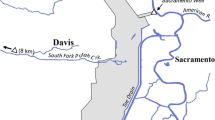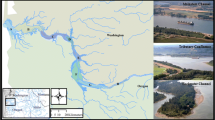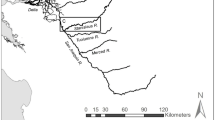Abstract
We investigated the geomorphology and environmental variables in which early- and late-run chum salmon groups spawn in an urban section of the Toyohira River, northern Japan, in relation to egg mortality, where a braided riverbed had been developing before river improvement occurred. Geomorphic units in the river channel having the highest proportions were riffles > the upwelling zone of gravel bars > pools > secondary channels. Most redds (> 60%) in the early-run group were built in the upwelling zone of gravel bars in the primary stream, indicating that salmon chose this geomorphic unit for spawning. A greater proportion of spawning redds in the late-run group occurred in secondary channels (i.e., smaller subsidiary channels that branch from the main, active channel). The buried-egg experiment showed that egg mortality was lower in the early-run group and higher in spawning redds that were shallower and had a higher maximum water temperature in winter. Late-run salmon need to select habitat with relatively higher water temperatures for spawning to compromise between egg mortality risk and the later timing of offspring hatching. Annual variation in the number of out-migrating fry was most associated with the number of spawning redds of the early-run group. A metropolitan river system may be highly regulated by humans and represents a monotonous river morphology, which nonetheless provides favorable spawning habitat for certain run-time populations because wild salmon may facultatively utilize limited diverse environments for natural reproduction.






Similar content being viewed by others
Data availability
Raw data are available by request from the corresponding author.
Code availability
All codes are available by request from the corresponding author.
References
Abe TK, Kitagawa T, Makiguchi Y (2019) Chum salmon migrating upriver adjust to environmental temperatures through metabolic compensation. J Exp Biol 222:jeb186189. https://doi.org/10.1242/jeb.186189
Ali MA, Hoar WS (1959) Retinal responses of pink salmon associated with its downstream migration. Nature 184:106–107. https://doi.org/10.1038/184106a0
Amano T (2009) Life on the Sakshukotni Riverbank. Introduction of Salmonology, Hokkaido University Press Sapporo, 185–193 (in Japanese)
Aruga N, Morita K, Suzuki T, Sato N, Okamoto M, Ohkuma K (2014) Evaluation of population viability of wild chum salmon Oncorhynchus keta in the Toyohira River, Sapporo metropolitan watershed, Japan. Nippon Suisan Gakk 80:946–955 (in Japanese with English abstract). https://doi.org/10.2331/suisan.80.946
Aruga N, Morita K, Kataoka T, Ueda K, Mukai T, Fujii K, Nunokawa M, Aruga M, Maruyama M, Watanabe K, Sato N, Nakamura S, Nishitani K, Okamoto M, Ohkuma K (2019) Example of restoration work to improve salmon spawning habitat in the Toyohira River. Research Report of the Sapporo Salmon Museum 1–22 (in Japanese).
Aruga N, Morita K, Aruga M, Ueda K, Watanabe K, Nakamura F (2021) Decadal changes in river geomorphology, and its effect on chum salmon spawning habitat, Toyohira River, Japan. Ecology and Civil Engineering 23:295–307 (in Japanese with English abstract). https://doi.org/10.3825/ece.20-00025
Aruga N, Suzuki T (2009) Environmental conditions and buried-egg mortality experiments on chum salmon spawning redds in the Toyohira River. FRA Salmonid Res Rep 3:3–5 (in Japanese)
Banerjee S, Banerjee A, Palit D (2021) Ecosystem services and impact of industrial pollution on urban health: evidence from Durgapur, West Bengal. India Environ Monit Assess 193:744. https://doi.org/10.1007/s10661-021-09526-9
Beacham TD (1984) Age and morphology of chum salmon in southern British Columbia. T Am Fish Soc 113:727–736. https://doi.org/10.1577/1548-8659(1984)113%3c727:AAMOCS%3e2.0.CO;2
Braga-Silva A, Galetti PM Jr (2015) Evidence of isolation by time in freshwater migratory fish Prochiloduscostatus (Characiformes, Prochilodontidae). Hydrobiologia 765:159–167. https://doi.org/10.1007/s10750-015-2409-8
Brunke M, Gonser T (1997) The ecological significance of exchange processes between rivers and groundwater. Freshwater Biol 37:1–33. https://doi.org/10.1046/j.1365-2427.1997.00143.x
Burner CJ (1951) Characteristics of spawning nests of Columbia River salmon. U.S. Fish Wildlife Serv Fish Bull 61:97–110
Cardenas MB, Ford AE, Kaufman MH, Kessler AJ, Cook LM (2016) Hyporheic flow and dissolved oxygen distribution in fish nests: the effects of open channel velocity, permeability patterns, and groundwater upwelling. J Geophy Res-Biogeo 121:3113–3130. https://doi.org/10.1002/2016JG003381
Cardinale BJ, Duffy JE, Gonzalez A, Hooper DU, Perrings C, Venail P, Narwani A, Mace G, Tilman D, Wardle DA, Kinzig AP, Daily GC, Loreau M, Grace J, Larigauderie A, Srivastava DS, Naeem S (2012) Biodiversity loss and its impact on humanity. Nature 486:59–67. https://doi.org/10.1038/nature11148
Church M (1992) Channel morphology and typology. In: Carlow P, Petts GE (eds) The rivers handbook: Oxford. Blackwell Scientific Publications, United Kingdom, pp 126–143
Coutts C, Hahn M (2015) Green infrastructure, ecosystem services, and human health. Int J Env Res Pub He 12:9768–9798. https://doi.org/10.3390/ijerph120809768
Dumas J, Marty S (2006) A new method to evaluate egg-to-fry survival in salmonids, trials with Atlantic salmon. J Fish Biol 68:284–304. https://doi.org/10.1111/j.0022-1112.2006.00907.x
Feist EB, Buhle ER, Arnold P, Davis JW, Scholz NL (2011) Landscape ecotoxicology of Coho Salmon spawner mortality in urban streams. PLoS ONE 6:e23424. https://doi.org/10.1371/journal.pone.0023424
Fraser BG, Williams DD (1998) Seasonal boundary dynamics of a groundwater/surface-water ecotone. Ecology 79:2019–2031. https://doi.org/10.1890/0012-9658(1998)079[2019:SBDOAG]2.0.CO;2
Gehrt SD, Anchor C, White LA (2009) Home range and landscape use of coyotes in a metropolitan landscape: conflict or coexistence? J Mammal 90:1045–1057. https://doi.org/10.1644/08-MAMM-A-277.1
Geist DR, Dauble DD (1998) Redd site selection and spawning habitat use by fall Chinook Salmon: the importance of geomorphic features in large rivers. Environ Manage 22:655–669. https://doi.org/10.1007/s002679900137
Geist DR, Hanrahan TP, Arntzen EV, McMichael GA, Murray CJ, Chien YJ (2002) Physicochemical characteristics of the hyporheic zone affect redd site selection by Chum Salmon and fall Chinook Salmon in the Columbia River. N Am J Fish Manage 22:1077–1085. https://doi.org/10.1577/1548-8675(2002)022%3c1077:PCOTHZ%3e2.0.CO;2
Greig SM, Sear DA, Carling PA (2007) A review of factors influencing the availability of dissolved oxygen to incubating salmonid embryos. Hydrol Process 21:323–334. https://doi.org/10.1002/hyp.6188
Hanrahan TP (2007) Bedform morphology of salmon spawning areas in a large gravel-bed river. Geomorphology 86:529–536. https://doi.org/10.1016/j.geomorph.2006.09.017
Hasegawa K, Takahashi S (2013) Microscale environment along the seaward route of stocked chum salmon fry. T Am Fish Soc 142:1232–1237. https://doi.org/10.1080/00028487.2013.804006
Hendry AP, Day T (2005) Population structure attributable to reproductive time: isolation by time and adaptation by time. Mol Ecol 14:901–916. https://doi.org/10.1111/j.1365-294X.2005.02480.x
Hilborn R, Bue BG, Sharr S (1999) Estimating spawning escapements from periodic counts: a comparison of methods. Can J Fish Aquat Sci 56:888–896. https://doi.org/10.1139/f99-013
Hoar WS (1958) The evolution of migratory behaviour among juvenile salmon of the genus Oncorhynchus. Journal of the Fisheries Board of Canada 15:391–428. https://doi.org/10.1139/f58-020
Hokkaido Salmon Hatchery (1929) Annual report. Hokkaido Salmon Hatchery, Sapporo (in Japanese)
Iida M, Imai S, Katayama S (2017) Effect of riverbed conditions on survival of planted eyed eggs in chum salmon Oncorhynchus keta. Fisheries Sci 83:291–300. https://doi.org/10.1007/s12562-016-1052-2
Iida M, Ban M, Noguvchi D, Miyauchi Y, Kitayama S (2018) Comparison of return rates of chum salmon Oncorhynchus keta released at various times into the Gakko River, Yamagata Prefecture, Japan. Aquaculture Science 66:137–140 (in Japanese with English summary). https://doi.org/10.11233/aquaculturesci.66.137
Ishida K (2002) How dams are built: Houheikyou Dam. HokkaiMonthly Report of Civil Eng Res Inst 588:3–6 (in Japanese)
Japan Map Center (1995) Sapporo in Maps 1, circa 1896. Midorikawa Map Printing Co
Jokimaki J, Jokimaki MLK, Suhonen J, Clergeau P, Pautasso M, Fernandez-Jiricic E (2011) Merging wildlife community ecology with animal behavioral ecology for a better urban landscape planning. Landscape Urban Plan 100:383–385. https://doi.org/10.1016/j.landurbplan.2011.02.001
Kamauchi H, Sato S, Hayashi D, Okabe Y, Katsuyama T, Fukushima K, Yoshioka A, Sato T, Tokuchi N, Nakaoka M (2012) Consumer of salmon carcasses in early winter of Eastern Hokkaido. For Res Kyoto 78:81–87 (in Japanese with English summary)
Kitada S (2014) Japanese chum salmon stock enhancement: current perspective and future challenges. Fisheries Sci 80:237–249. https://doi.org/10.1007/s12562-013-0692-8
Kobayashi T (1953) An ecological study on the salmon fry, Oncorhynchus keta (3) Observation on the out-migration of salmon fry, 1. Sci Rep Hokkaido Salmon Hatchery 8:81–85 (in Japanese with English summary)
Kudo T, Konishi H, Kanaya M (2012) River channel changes in the Toyohira River and its condition after the 2011 flood. Hokkaido Development Technology Research and Presentation Meeting 2011 (in Japanese).
Leman VN (1993) Spawning site of Chum Salmon, Oncorhynchus keta: microhydrological regime and viability of progeny in redds (Kamchatka River Basin). J Ichthyol 33:104–117
Leopold LB, Wolman MG, Miller JP (1964) Fluvial processes in geomorphology. Freeman, San Francisco, CA, p 522
Lisi PJ, Schindler DE, Bentley KT, Pess GR (2013) Association between geomorphic attributes of watersheds, water temperature, and salmon spawn timing in Alaskan streams. Geomorphology 185:78–86. https://doi.org/10.1016/j.geomorph.2012.12.013
Lotspeich FB, Everest FH (1981) A new method for reporting and interpreting textural composition of spawning gravel. U.S. Forest Service Research Note PNW-369
Malcolm IA, Youngson AF, Soulsby C (2003) Survival of salmonid eggs in a degraded gravel-bed stream: effects of groundwater-surface water interactions. River Res Appl 19:303–316. https://doi.org/10.1002/rra.706
Moir HJ, Pasternack GB (2008) Relationships between mesoscale morphological units, stream hydraulics and Chinook salmon (Oncorhynchustshawytscha) spawning habitat on the Lower Yuba River, California. Geomorphology 100:527–548. https://doi.org/10.1016/j.geomorph.2008.02.001
Montgomery DR, Buffington JM (1997) Channel-reach morphology in mountain drainage basins. Geol Soc Am Bull 109:596–611. https://doi.org/10.1130/0016-7606(1997)109%3c0596:CRMIMD%3e2.3.CO;2
Montgomery DR, Beamer EB, Pess GR, Quinn TP (1999) Channel type and salmonid spawning distribution and abundance. Can J Fish Aquat Sci 56:377–387. https://doi.org/10.1139/f98-181
Morita K (2018) Earlier migration timing of salmonids: an adaptation to climate change or maladaptation to the fishery? Can J Fish Aquat Sci 76:475–479. https://doi.org/10.1139/cjfas-2018-0078
Morita K, Nagashima A (2015) Temperature seasonality during fry out-migration influences the survival of hatchery-reared chum salmon Oncorhynchus keta. J Fish Biol 87:1111–1117. https://doi.org/10.1111/jfb.12767
Morita K, Saito T, Miyakoshi Y, Fukuwaka MA, Nagasawa T, Kaeriyama M (2006) A review of Pacific salmon hatchery programmes on Hokkaido Island, Japan. ICES J Mar Sci 63:1353–1363. https://doi.org/10.1016/j.icesjms.2006.03.024
Morita K, Hirama Y, Miyauchi Y, Takahashi S, Ohnuki T, Ohkuma K (2013) Efficiency of natural reproduction of chum salmon in the Chitose River, Hokkaido, Japan. Nippon Suisan Gakk 79:718–720 (in Japanese). https://doi.org/10.2331/suisan.79.657
Mouw JEB, Tappenbeck TH, Stanford JA (2014) Spawning tactics of summer chum salmon Oncorhynchus keta in relation to channel complexity and hyporheic exchange. Environ Biol Fish 97:1095–1107. https://doi.org/10.1007/s10641-013-0200-0
Nakamura F, Seo J, Akasaka T, Swanson FJ (2017) Large wood, sediment, and flow regimes: Their interactions and temporal changes caused by human impacts in Japan. Geomorphology 279:176–187. https://doi.org/10.1016/j.geomorph.2016.09.001
Okamoto M (2001) Records of chum salmon hatchery and release programs in the Toyohira River (1979-2000) and Trait values of parent fish and eggs. Bulletin of the Sapporo Salmon Museum 13:32–46. (In Japanese)
Olsen JB, Flannery BG, Beacham TD, Bromaghin JF, Crane PA, Lean CF, Dunmall KM, Wenburg JK (2008) The influence of hydrographic structure and seasonal run timing on genetic diversity and isolation-by-distance in chum salmon (Oncorhynchus keta). Can J Fish Aquat Sci 65:2026–2042. https://doi.org/10.1139/F08-108
Peterson NP, Quinn TP (1996) Spatial and temporal variation in dissolved oxygen in natural egg pockets of chum salmon, in Kennedy Creek, Washington. J Fish Biol 48:131–143. https://doi.org/10.1111/j.1095-8649.1996.tb01424.x
Rubin JF, Glimsäter C (1996) Egg-to-fry survival of the sea trout in some streams of Gotland. J Fish Biol 48:585–606. https://doi.org/10.1111/j.1095-8649.1996.tb01454.x
Sakata Y, Ito K, Ikeda R (2011) A distribution model of permeability derived from undisturbed gravelly samples in alluvial fan. Japanese Geotechnical Journal 6:109–119 (in Japanese with English summary). https://doi.org/10.3208/jgs.6.109
Salo EO (1991) Life history of chum salmon (Oncorhynchus keta). Pacific salmon life histories. UBC Press, 233–309
Sapporo City History Editorial Board (1953) Sapporo fan area old river map, history of Sapporo city politics and administration. Sapporo City, Japan
Schindler DE, Hilborn R, Chasco B, Boartright CP, Quinn TP, Rogers LA, Webster MS (2010) Population diversity and the portfolio effect in an exploited species. Nature 465:609–612. https://doi.org/10.1038/nature09060
Scholz NL, Myers MS, McCarthy SG, Labenia JS, McIntyre JK, Ylitalo MG, Rhodes DL, Laetz AC, Stehr MC, French LB (2011) Recurrent die-offs of adult coho salmon returning to spawn in Puget Sound lowland urban streams. PLoS ONE 6:e28013. https://doi.org/10.1371/journal.pone.0028013
Smith AK (1973) Development and application of spawning velocity and depth criteria for Oregon salmonids. T Am Fish Soc 102:312–316. https://doi.org/10.1577/1548-8659(1973)102%3c312:DAAOSV%3e2.0.CO;2
Spromberg JA, Baldwin DH, Damm SE, McIntyre JK, Huff M, Sloan CA, Anulacion BF, Davis JW, Scholz NL (2016) Coho salmon spawner mortality in western US urban watersheds: bioinfiltration prevents lethal storm water impacts. J Appl Ecol 53:398–407. https://doi.org/10.1111/1365-2664.12534
Suzuki T (2008) Grappling with conservation of chum salmon resource considering natural reproduction. FRA Salmonid Research Report 2:3–5 (in Japanese)
Swales S, Lauzier RB, Levings CD (1986) Winter habitat preferences of juvenile salmonids in two interior rivers in British Columbia. Can J Zool 64:1506–1514. https://doi.org/10.1139/z86-225
Takahashi M, Nakamura F (2011) Impacts of dam-regulated flows on channel morphology and riparian vegetation: a longitudinal analysis of Satsunai River, Japan. Lands Ecol Eng 7:65–77. https://doi.org/10.1007/s11355-010-0114-3
Thatcher HR, Downs CT, Koyama NF (2020) Understanding foraging flexibility in urban vervet monkeys, Chlorocebuspygerythrus, for the benefit of human-wildlife coexistence. Urban Ecosyst 23:1349–1357. https://doi.org/10.1007/s11252-020-01014-1
The Geospatial Information Authority of Japan (1918) Topographic map at 1/25,000 scale
The Geospatial Information Authority of Japan (2021) Flood control topographic classification map
Tonia D (2005) Interaction between river morphology and intra-gravel flow paths within the hyporheic zone, PhD dissertation, 129 pp. Univ. of Idaho, Boise
Tonia D, Buffington JM (2011) Effects of stream discharge, alluvial depth and bar amplitude on hyporheic flow in pool-riffle channels. Water Resour Res 47:1–13. https://doi.org/10.1029/2010WR009140
Ueta M, Koita M, Fukui K (1999) The relationship between the autumn distributions of salmon and of Steller’s and White-tailed Sea Eagles in Hokkaido, Japan. Strix 17:25–29 (in Japanese with English summary)
Webb HJ, McLay HA (1996) Variation in the time of spawning of Atlantic salmon (Salmo salar) and its relationship to temperature in the Aberdeenshire Dee, Scotland. Can J Fish Aquat Sci 53:2739–2744. https://doi.org/10.1139/f96-240
Winter TC, Harvey JW, Franke OL, Alley WM (1998) Groundwater and surface water, a single resource. US Geological Survey Circular 1139
Wohl E, Allen AO, Mersel MK, Kichefski SL, Fritz KM, Lichvar RW, Vanderbilt FB (2016) Synthesizing the scientific foundation for ordinary high water mark delineation in fluvial systems. US Army Engineer Research and Development Center (ERDC) Hanover United States.
Wookey OA (2022) Human-wildlife coexistence in the urban domain: promoting welfare through effective management, responsibility and the recognition of mutual interest. Human/Animal Relationships in Transformation 317–338. https://doi.org/10.1007/978-3-030-85277-1_15
Zari MP (2018) The importance of urban biodiversity — an ecosystem services approach. Biodivers Int J 2:357–360. https://doi.org/10.15406/bij.2018.02.00087
Zhou T, Endreny AT (2013) Reshaping of the hyporheic zone beneath river restoration structures: flume and hydrodynamic experiments. Water Resour Res 49:1–12. https://doi.org/10.1002/wrcr.20384
Acknowledgements
We thank the members of the Sapporo Wild Salmon Project and staff of the Sapporo Salmon Museum, Fisheries Resources Institute, Japan Fisheries Research and Education Agency, for their cooperation in the field study. We are grateful to JN Negishi for advice on depicting the groundwater levels in the schematic figures; we also thank H. Tanaka for the figure illustrations. We appreciate the anonymous reviewers for their valuable comments on earlier versions of the manuscript.
Funding
This study was partly supported by the research fund for the Ishikari and Tokachi Rivers provided by the Ministry of Land, Infrastructure, Transport, and Tourism of Japan, and by the JSPS KAKENHI grant numbers 21H03647 and 20H01441.
Author information
Authors and Affiliations
Contributions
NA and KM conceived the research idea. NA, KM, MA, KU, KF, KO, and KW designed the methods and performed the collections. NA and KM analyzed the data. NA, KM, and FN led the writing of the manuscript. All authors contributed critically to the drafts and gave final approval for publication.
Corresponding author
Ethics declarations
Ethics approval
The survey was conducted with the permission of the Governor of Hokkaido, Japan. The buried salmon eggs were handled appropriately.
Consent to participate
Not applicable.
Consent for publication
The authors consent to publication of the manuscript.
Conflict of interest
The authors declare no conflict of interests.
Additional information
Publisher's note
Springer Nature remains neutral with regard to jurisdictional claims in published maps and institutional affiliations.
Supplementary Information
Below is the link to the electronic supplementary material.
Rights and permissions
Springer Nature or its licensor (e.g. a society or other partner) holds exclusive rights to this article under a publishing agreement with the author(s) or other rightsholder(s); author self-archiving of the accepted manuscript version of this article is solely governed by the terms of such publishing agreement and applicable law.
About this article
Cite this article
Aruga, N., Morita, K., Aruga, M. et al. Spawning habitat characteristics and egg mortality in relation to river geomorphology and run-times of chum salmon (Oncorhynchus keta) in a metropolitan river system, northern Japan. Environ Biol Fish 106, 1277–1293 (2023). https://doi.org/10.1007/s10641-023-01415-z
Received:
Accepted:
Published:
Issue Date:
DOI: https://doi.org/10.1007/s10641-023-01415-z




